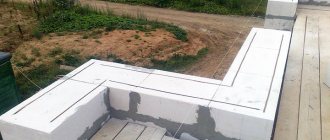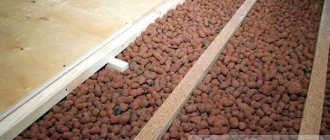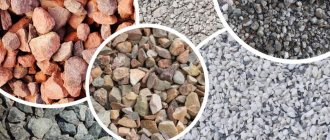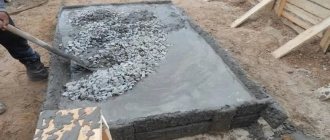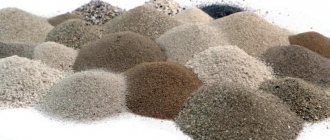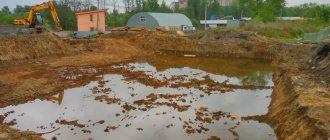Crushed stone pavement is faster and cheaper to build than an asphalt road. This option is often found in rural areas, new suburban residential complexes, private cooperatives, and when temporary access to the site of construction work is organized. A road made of crushed stone is not washed away by water; such backfill can withstand significant loads. Even if heavy trucks sometimes drive on the surface, they will not cause significant harm to it. The canvas will last a long time if it is laid without violating the technology. The crushed stone road fits well into any environment and harmoniously combines with the countryside. Many who plan to build a simple road ask questions: How to make a road out of crushed stone? Which crushed stone is better to buy for this: granite or limestone? Will the coating really be cheap and will it cope with its function? Let's understand the intricacies!
Peculiarities
The crushed stone surface is universal. It works just as well in a natural, open landscape as it does in a residential setting. The coating goes well with traditional houses and ultra-modern architecture. Contrary to popular belief, a crushed stone driveway is quite durable if done correctly, and its construction is a very difficult process. Simply ordering delivery and filling several cars with crushed stone is not enough. Backfilling is done with different materials, and each layer is compacted after backfilling. Carrying out the entire procedure according to the technology makes it possible to drain rain and melt water with the greatest efficiency, as well as correctly distribute the load inside the pavement pie, extending the service life.
Feasibility of creating gravel paths
The design of the road and path network on the site begins immediately after determining the location for the construction of a house and auxiliary premises. After studying the relief features of the territory, they proceed to drawing up a plan on paper, where they mark the main and auxiliary paths and passages. At this stage, a decision is made on the width and type of paving of the road network.
Main paths (from the gate to the central entrance, from the house to the utility room, summer kitchen), which will be subject to heavy loads, are best made of slabs, paved with natural or artificial stone. These materials are durable, resistant to stress, easier to clean in winter, and comfortable to walk on. A gravel path can be adjacent to the main road, be the main one in a recreation area or in a garden, or duplicate it. If the path is made of loose gravel, it is more difficult to move along due to the viscosity of the material, and it is impractical in winter.
What do you need?
Granite and limestone crushed stone with uneven and sharp edges is suitable for crushed stone coating - it wedges and compacts well, which makes the surface durable. A road for cars must withstand heavy loads, so the road cake consists of three to four layers of aggregates of different fractions. After laying each layer of aggregate, the surface is compacted with a roller.
List of fillers:
♦ coarse sand; ♦ crushed stone fraction 40-70 mm; ♦ crushed stone fraction 20-40 mm; ♦ crushed stone fraction 5-20 mm;
Technique:
♦ grader; ♦ skating rink;
Other:
♦ water; ♦ devices for watering;
You can also use gravel, but in addition to river gravel. River gravel has rounded grains, so it moves a lot during work, and the surface it produces is not very stable.
Advantages and disadvantages of paths made of crushed stone or gravel
The advantages of rocky paths include:
- aesthetics, the ability to choose a material that matches the style and color of the home’s decoration;
- durability of the coating;
- relatively low cost;
- a garden with a gravel path requires less labor for weeding;
- good drainage capacity in conditions of excess rain.
Disadvantages of loose paving with low binding properties:
- if stones with sharp edges hit, there is a possibility of injury, not suitable for families with small children;
- if the material is incoherent, it is difficult to move on it, it is impossible to transport carts, baby strollers and wheelchairs;
- it is difficult to clear leaves; sprouting weeds must be removed only by hand;
- not suitable for winter use, it is impossible to clear snow and chip ice on them;
- the pebble path can be damaged by moles;
- the complexity of preparing the bed.
Stages of work
Depending on the location of the road and natural factors, various ditches, ditches and drainage systems are constructed during construction to drain water. After all, everyone knows that water can quickly ruin any road if its contact with the surface is not reduced to a minimum.
The layer of crushed stone for travel should be about 40 cm high. The shape of the road should have a convex profile and form transverse slopes - approximately 4% on each side of the axis. This will ensure proper drainage of the road surface and prevent it from softening and forming ruts. The work is carried out according to the following chronology:
First of all, it is necessary to remove the top soil layer to a depth of 20-30 cm. For this you will need a grader or bulldozer.
To strengthen the road base, geotextiles are laid underneath the layers. Without geotextiles, crushed stone will sink into the ground, but with it it is stable and lies firmly in place without moving. Geotextiles can even be laid directly on the ground without removing the top layer, which simplifies and reduces the cost of work. Sheets of fabric are overlapped 10-15 cm.
A sand cushion is installed to drain the incoming water. Thanks to this, the coating will not wash out or change shape. Coarse sand is poured in a layer of about 20 cm and compacted well. If the road is built on sandy soils, then such bedding need not be done. This is simply no longer necessary.
The first layer consists of crushed stone with a fraction of 40–70 mm. Its height should be 10-20 cm. Crushed concrete or broken brick can also be used for these purposes. Although broken brick is not the best option on damp soils, over time it becomes saturated with moisture and becomes brittle. The resulting layer is watered on top and compacted. If desired, this layer can be covered to keep the stones in place and not “walk around”. For covering, geotextiles are used or the material is poured into a special road mesh. But these materials are not used to save money.
The next layer is a layer of crushed stone of a finer fraction - 20-40 mm. It, like the layer above, is watered, compacted, and covered with geotextiles.
After laying two layers of crushed stone, a grader should go over the pie and level the surface well according to the design.
Lastly, the surface is strengthened with fine crushed stone 5-20 mm. This material serves to fill the space formed between large particles. After rolling, the canvas becomes dense and convenient for vehicle movement.
Designer recommendations
Gravel paths are ideal for landscape style gardens. They are made tortuous with thin, barely noticeable borders made of polymer materials. To emphasize the closeness to nature, the width of the passage can be slightly varied.
Highways made of large pebbles would be appropriate in a vegetable garden with a regular arrangement of beds. If the base is made correctly, the stones help drain excess moisture. Plants will be less affected by diseases.
Pebbles look natural around artificial reservoirs; they can fill the space around an alpine slide. Combined paths are aesthetically pleasing; their central part is made of slabs or natural stone, and the space around is covered with pebbles.
Designers are increasingly using pebbles painted in different colors to create flower beds. If there is a dry stream planned in the garden, then a gravel path should not be led to it. These landscape elements will merge and will not be expressive.
Large sea pebbles with straight edges and a smooth surface can be used for paving paths, and the gaps between the pebbles can be filled with fine gravel or crushed stone. Individual stones can be painted in different colors, creating a composition of flower petals or any other.
Caring for gravel and crushed stone paths
The most labor-intensive paths to maintain are those with pebble and crushed stone surfaces, where the stones have the least adhesion to each other. Level and smooth stones tend to shift after each pass over them. Such paths require frequent leveling with a wooden batten.
Autumn falling leaves should be removed in a timely manner, preventing their accumulation on the road surface during the wintering period. Decaying leaves leave behind clinging dirt and change the color of the pebbles. Emerging weeds should be carefully trimmed with pruning shears as low and early as possible; if they develop a deep root system, this will inevitably lead to deformation of the gravel surface.
After snowy winters and rapid snow melt, the path may look sagging in many places. This phenomenon occurs if there is a redistribution of the load on the coating. In this case, the material is added. If the problem repeats from year to year, you should remove the top base layer and further strengthen the base by adding a polymer mesh.
Thus, it cannot be said that building and maintaining gravel paths on your own is a simple and easy matter. It requires experience and dexterity, physical strength, patience and endurance, mathematical calculations and free funds for the purchase and delivery of materials, and a lot of space for storing them. It is especially difficult to dig a long pit with a depth of more than 30 cm, as well as to lay large areas under geogrids.
How is the strength of layers distributed?
| Pavement area | Short description |
| Upper structural layers | They have higher strength and hardness. Designed to resist mechanical wear, deformation and stretching. |
| Lower structural layers | They have lower strength and hardness. Designed to resist compression and shear. |
In other words, the further from the surface, the lower the strength and hardness of the materials, since different depths are subject to loads of different types.
. It is thanks to this laying format that road pavement has high and balanced physical and mechanical characteristics.
Length of unpaved roads by country[edit]
| A country | Length of dirt roads (km) [11] |
| Afghanistan | 29 800 |
| Albania | 10 980 |
| Algeria | 26 050 |
| American Samoa | No data |
| Andorra | No data |
| Angola | 46 080 |
| Anguilla | 93 |
| Antigua and Barbuda | 784 |
| Argentina | 161 962 |
| Armenia | No data |
| Australia | 727 645 |
| Austria | No data |
| Azerbaijan | 26 153 |
| Bahamas, | 1,080 |
| Bahrain | 730 |
| Bangladesh | 19 248 |
| Barbados | No data |
| Belarus | 11 741 |
| Belgium | 33 498 |
| Belize | 2382 |
| Benin | 14 600 |
| Bermuda | 447 |
| Butane | 7 603 |
| Bolivia | 80 776 |
| Bosnia and Herzegovina | 3500 |
| Botswana | No data |
| Brazil | 1,368,166 |
| British Indian Ocean Territory | No data |
| British Virgin Islands | No data |
| Brunei | 417 |
| Bulgaria | 277 |
| Burkina Faso | No data |
| Burma | No data |
| Burundi | 10 822 |
| Cape Verde | 418 |
| Cambodia | 41 102 |
| Cameroon | 47 422 |
| Canada | 626 700 |
| Cayman islands | No data |
| Central African Republic | 18 893 |
| Chad | No data |
| Chile | 59 645 |
| China | 531 000 |
| Christmas Island | 110 |
| Cocos (Keeling) Islands | 12 |
| Colombia | No data |
| Comoros | 207 |
| Congo, Democratic Republic | 150 703 |
| Congo, Republic | 15 788 |
| Cook Islands | 287 |
| Costa Rica | 28 885 |
| Ivory Coast | 75 494 |
| Croatia | No data |
| Cuba | 31 038 |
| Curacao | No data |
| Cyprus | 8 564 |
| Czech | No data |
| Denmark | No data |
| Djibouti | 1,686 |
| Dominica | 750 |
| Dominican Republic | 9 833 |
| Ecuador | 37 198 |
| Egypt | 10 688 |
| El Salvador | 2,565 |
| Equatorial Guinea | No data |
| Eritrea | 3136 |
| Estonia | 47 985 |
| Eswatini | 2,516 |
| Ethiopia | 96 060 |
| European Union | No data |
| Falkland Islands (Islas Malvinas) | 390 |
| Faroe islands | No data |
| Fiji | 1,754 |
| Finland | 350 000 |
| France | No data |
| French polynesia | 855 |
| Gabon | 8 073 |
| Gambia, | 3029 |
| Gaza Strip | No data |
| Georgia | No data |
| Germany | No data |
| Ghana | 95 728 |
| Gibraltar | No data |
| Greece | 75 603 |
| Greenland | No data |
| Grenada | 225 |
| Guam | No data |
| Guatemala | 10 132 |
| Guinea | 40 006 |
| Guinea-Bissau | 2,490 |
| Guyana | 7,380 |
| Haiti | 3 498 |
| Honduras | 11 375 |
| Hong Kong | No data |
| Hungary | 126 514 |
| Iceland | 8,108 |
| India | No data |
| Indonesia | 213 505 |
| Iran | 38 500 |
| Iraq | No data |
| Ireland | No data |
| Isle Of Man | No data |
| Israel | No data |
| Italy | No data |
| Jamaica | 5 973 |
| Japan | 225 937 |
| Jersey | No data |
| Jordan | No data |
| Kazakhstan | 10 278 |
| Kenya | 147 032 |
| Kiribati | No data |
| Korea, North | 24 830 |
| Korea, South | 7 633 |
| Kosovo | 91 |
| Kuwait | No data |
| Kyrgyzstan | No data |
| Laos | 34 171 |
| Latvia | 55 233 |
| Lebanon | No data |
| Lesotho | 4871 |
| Liberia | 9 943 |
| Libya | 42 810 |
| Liechtenstein | No data |
| Lithuania | 11 869 |
| Luxembourg | No data |
| Macau | No data |
| Macedonia | 4,549 |
| Madagascar | 31 373 |
| Malawi | 11 378 |
| Malaysia | 28 234 |
| Maldives | No data |
| Mali | 16 952 |
| Malta | 392 |
| Marshall Islands | No data |
| Mauritania | 8 265 |
| Mauritius | 49 |
| Mexico | 240 116 |
| Micronesia, Federated States | 204 |
| Moldova | 517 |
| Monaco | No data |
| Mongolia | 44 449 |
| Montenegro | 621 |
| Montserrat | No data |
| Morocco | 17 279 |
| Mozambique | 23 718 |
| Namibia | 37 751 |
| Nauru | 6 |
| Nepal | 16 100 |
| Netherlands | No data |
| New Caledonia | No data |
| New Zealand | 32 400 |
| Nicaragua | 20 551 |
| Niger | 15 037 |
| Nigeria | 164 220 |
| Niue | No data |
| Norfolk Island | 27 |
| Northern Mariana Islands | No data |
| Norway | 18 116 |
| Oman | 30 545 |
| Pakistan | 78 879 |
| Panama | 8 786 |
| Papua New Guinea | 6 349 |
| Paraguay | 27 199 |
| Peru | No data |
| Philippines | 155 294 |
| Poland | 129 000 |
| Portugal | 11 606 |
| Puerto Rico | No data |
| Qatar | No data |
| Romania | 34 312 |
| Russia | 355 666 |
| Rwanda | 3 493 |
| Saint Helena, Ascension and Tristan da Cunha | 30 |
| Saint Kitts and Nevis | 220 |
| Saint Lucia | 363 |
| Saint Pierre and Miquelon | 37 |
| Saint Vincent and the Grenadines | 249 |
| Samoa | 95 |
| San Marino | No data |
| Sao Tome and Principe | 102 |
| Saudi Arabia | 173 843 |
| Senegal | 10 539 |
| Serbia | 16 248 |
| Seychelles | 12 |
| Sierra Leone | 10 396 |
| Singapore | No data |
| Sint Maarten | No data |
| Slovakia | No data |
| Slovenia | No data |
| Solomon islands | 1,356 |
| Somalia | 19 492 |
| South Africa | 588 062 |
| southern Sudan | No data |
| Spain | No data |
| Sri Lanka | 97 116 |
| Sudan | 7 580 |
| Suriname | 3 174 |
| Sweden | 433 034 |
| Switzerland | No data |
| Syria | 6 813 |
| Taiwan | 396 |
| Tajikistan | No data |
| Tanzania | 79 380 |
| Thailand | No data |
| Timor-Leste | 3 440 |
| Go | 9 205 |
| Tonga | 496 |
| Trinidad and Tobago | 4 068 |
| Tunisia | 4,662 |
| turkey | 33 486 |
| Turkmenistan | 11 015 |
| Turks and Caicos Islands | 97 |
| Tuvalu | No data |
| Uganda | 16 287 |
| Ukraine | 3,599 |
| United Arab Emirates | No data |
| United Kingdom | No data |
| United States | 2,281,895 |
| Uruguay | 69 989 |
| Uzbekistan | 10 985 |
| Vanuatu | 814 |
| Venezuela | No data |
| Vietnam | 47 130 |
| Virgin Islands | No data |
| West Coast | No data |
| World | No data |
| Yemen | 65 100 |
| Zambia | 31 051 |
| Zimbabwe | 78 786 |
| GENERAL | 11 705 250 |
Covering with geogrid
The use of volumetric and single-plane polymer meshes is advisable on roads with slopes, where the main soil of a light mechanical composition with a low clay content slides from the main place, or the roads are planned to be operated under high mechanical loads. In areas with uneven terrain, it may be necessary to strengthen paths against landslides from above or crumbling of the road surface downwards. In this case, you can build vertical retaining walls, and if the slopes are gentle, also strengthen them with geogrids, which are covered with crushed stone mixed with a binder component (epoxy resin and glue).
To lay the geogrid, it is enough to remove the turf layer, dig up the soil and compact it. Geofabric is placed on the base and a grating is laid out. To fix the geogrid to the ground, thick wire staples are used. They are inserted into each link on light soil and after 1-2 links on loamy soil. The grid cells are covered with crushed stone or gravel of fraction 5-10 so that the grid is covered with a rocky layer of more than 5 cm, otherwise after the stones shrink, the grid will be felt under your feet and it will be uncomfortable to walk on.
Can grates be filled with stone resin?
Volumetric and single-plane polymer gratings can be filled with a mixture of crushed stone and adhesive components. In this case, the coating will be durable and you can drive a car or bicycle on it. At the dacha, this way you can pave the area for a summer kitchen or a parking space.
Fill compaction
This part has a greater influence on the formation of the quality characteristics of the coating than the initial application of asphalt chips or crushed stone. Before compaction, each layer is leveled in accordance with the longitudinal slope. Next, you can begin rolling the road surface using special equipment over the entire width of the road. In some areas in cramped areas, spot compaction may be necessary. To ensure that the road surface is solid along the entire horizontal plane, problem areas are compacted manually using vibration-impact actions. At the same time, tamping slabs cannot be used in areas where utility lines are laid.
If loose aggregates are used for road surfaces, it is recommended to compact them with lattice or pad rollers. This technique is used at the first stage; it is also possible to use machines with pneumatic tires, which have an incomplete ballast load of 10-15 tons. At the final stage of compaction, the road fill is compacted with pneumatic tires, the weight of which reaches 25 tons.
Content
- 1 Characteristics 1.1 Design
- 1.2 Materials 1.2.1 Laterite and murram roads
- 1.3.1 Dust control 1.3.1.1 Calcium chloride as a dust suppressant
- 2.1 Forestry road
Where are “primers” needed?
The construction of dirt roads is advisable on routes with low traffic, relatively cheap, but for all-season operation it will require competent and constant “prevention”. They must be watered every summer with calcium chloride (to remove dust) and passed with a grader at least once a month. In Finland, such “primers”, if the technology is followed, last for half a century.
It is technology that is our “stumbling block” so far. For uniform spreading of crushed stone screenings (in Finland, for example), a special installation is used. We don’t produce special equipment of this class (let’s hope “yet”), they are brought and scattered by dump trucks, raked with a grader and compacted with a roller. To transport Finnish or German equipment across the border and use it, you will have to pay so much money that the dirt road will become “golden”.
According to Russian SNiP, a dirt road will be any road built using only soil or soil with additives (gravel, slag, etc.). It is a 5th (lowest) class road and can be either with road “clothing” - coating (also of the lowest class) or without it. Divided into 3 classes:
- Improved unpaved, with a road surface made of sand and gravel mixture, crushed stone, etc. They are indicated in yellow on the maps.
- Country dirt roads (not improved). Just a “known” road, which, at best, is sometimes “smoothed” by a grader. On maps they are indicated by a solid line.
- Field and forest dirt roads. In fact - 2 parallel “paths”. On maps they are indicated by a dotted line.
Helpful advice: when driving along field and forest roads, try to move so that the wheels are located on the side of the road and in the middle of such a road. Perhaps the “pioneer” of this route is a car with high ground clearance. Then “grabbing” something into the wheel will be much more harmless than running into an overgrown stump in the middle with a pallet.
Geotextiles
Geotextiles
outwardly resembles ordinary fabric, but it is made of durable synthetic materials. In the construction of highways, geotextiles made from polypropylene or polyester synthetic fibers are most often used, but some other materials can also be used as starting materials.
This geo-fabric is characterized by high strength, sufficient elasticity, long service life and environmental friendliness.
Road pavement with geotextiles has higher characteristics due to the properties of this material:
- Creation of a reinforcing effect (in combination with geogrid, the strength of the structure can be increased by 2-2.5 times);
- Separation of structural layers;
- Drainage function;
- Prevents the germination of plants from the soil.
Considering that about 80% of the soil in our country is considered clayey, the use of geotextiles is simply necessary to ensure sufficient strength and moisture insulation.
Why is road clothing made multi-layered?
Optimally selected materials of structural layers, as well as their quantity and thickness, make it possible to most effectively absorb external loads on the road surface, as well as ensure high strength and stability of the entire structure.
Thanks to the correct design of the road, the load created by traffic flow is redistributed over a larger area, and also attenuates as it deepens. Accordingly, the pavement must have characteristics suitable for the design load on the road surface.
Example
. For a federal highway, along which not only passenger but also freight vehicles constantly move, the thickness of some technological layers will be greater, and the materials used will be of better quality. In addition, it is necessary to take into account the increase in traffic load in the future. It is also possible to use additional materials and technologies to strengthen the structure.
Classification of road pavements
Road pavement with a typical design was described above. However, in some cases, road pavement may have fewer structural layers, and at the same time the category of the coating is reduced. Road pavements can be classified according to their rigidity and level of performance characteristics.
Depending on the hardness, the following are distinguished:
- Rigid pavement – has cement concrete in the base or covering;
- Flexible pavement is a structure without the use of cement concrete.
In the Russian climate, the use of cement concrete as a coating is impossible, since this material is destroyed under the influence of low temperatures combined with transport load.
However, non-rigid road pavement has fairly high physical and mechanical characteristics.
, which are quite suitable for the construction of high-category roads.
Links[edit]
- ↑
Kiwi - Words and phrases archived 02/09/2010 in the Wayback Machine (from a private website) - Anon. "Metal". Internet Etymological Dictionary
. 2001 Douglas Harper. Retrieved January 29, 2010. - Pennsylvania State Conservation Commission and Center for Dirt and Gravel Road Research at Pennsylvania State University (2018 ) Driving Surface Aggregate (DSA) Data Handbook
. University Park. Available at: https://www.dirtandgravel.psu.edu/sites/default/files/General Resources/DSA/DSA_Handbook_2018_03.pdf (accessed April 6, 2022). - Gravel Roads: A Construction and Maintenance Guide
. Washington: Department of Transportation (DOT), Federal Highway Administration (FHWA). 2015. ISBN. 9780160929915. - BC Supplement to TAC Geometric Design Guide. — 2007 edition
. British Columbia: British Columbia. Ministry of transportation. 2007. ISBN 978-0-7726-5800-5. - Scorset, Ken; Selim, Ali A. (November 2000), "Title III: Surface Gravel" (PDF), Gravel Roads: Maintenance and Design Manual (PDF), FHWA, Federal Highway Administration - South Dakota Local Transportation Assistance Program, pp. 39–49
- Skorseth, Ken (2005). Gravel Roads: Operation and Design Guide
. South Dakota Local Transportation Assistance Program. ISBN 2005410659. OCLC 62208163. - Gravel Roads: A Construction and Maintenance Guide
. Washington: Department of Transportation (DOT), Federal Highway Administration (FHWA). 2015. ISBN. 9780160929915. - 'GRAVEL ROADS MAINTENANCE GUIDE A Guide for Landowners on Campgrounds and Other Gravel Roads' (2016). Augusta (April). Available at: https://www.maine.gov/dep/land/watershed/camp/road/gravel_road_manual.pdf (accessed April 9, 2022).
- ^ ab Caouette, Leo. 2013. METHODS OF USING CALCIUM CHLORIDE AS DUST SUPPRESSION. Nunavut: Nunavut Municipal Training Organization. https://www.nmto.ca/sites/default/files/application_of_calcium_chloride.pdf.
- "Field List::Roads - World Directory - Central Intelligence Agency". www.cia.gov
. Retrieved March 30, 2022.
Table: Application of geosynthetics depending on density
| Application area | Density, g/sq.m |
| Garden paths, drainage systems, green areas | Geotextile 100 and Geotextile 150 |
| Artificial ponds, pedestrian zone (sidewalks) | Geotextile 200 and Geotextile 250 |
| Roads for cars, parking lots | Geotextile 400 |
| Roads for heavy vehicles | Geotextile 450 and Geotextile 500 |
| Highways, railways and local airline runways | Geotextile 550 and Geotextile 600 |
Do you have questions about choosing geotextiles, calculating quantities or purchasing? Call now on the number
+7
Soil strengthening methods
There are many methods by which it is possible to strengthen the soil:
- granulometric additives (crushed stone, sand, loam, gravel, etc.);
- organic binders (tars, bitumens, emulsions, resins);
- mineral binders (sodium silicate, lime and cement);
- solutions of salts (sodium and calcium chloride, etc.);
- soil treatment with electrochemistry (passing direct current using electrolytes);
- heat treatment (firing the soil using local fuel);
- complex soil treatment.


